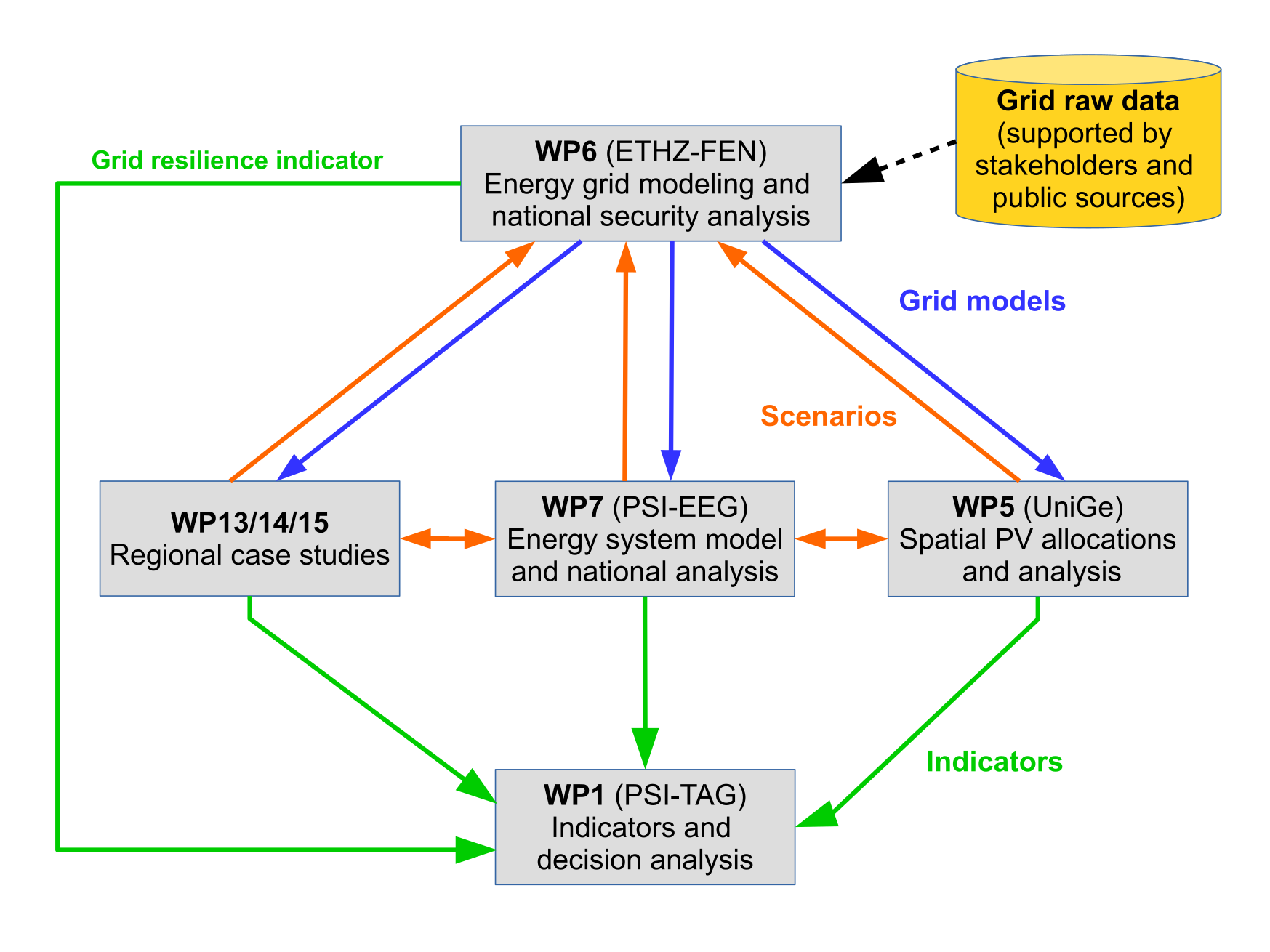SWEET 2020 RC4: SURE
SUstainable and Resilient Energy for Switzerland (SURE)
Partners: PSI, ETHZ, EPFL, USI, TEP, SUPSI, UNIBE, UNIGE, ZHAW, E3M
Duration: 2021 - 2025
Funding: SFOE
Project Leader: Dr. Tom Kober at PSI. FEN is leading WP6 on "Energy grid modeling and security analysis".
Project Team: Dr. Alexander Fuchs, Dr. Turhan Demiray
SURE Objective: The main question of “Research Challenge 4” in SWEET Call 2020 on how to identify and evaluate pathways to the energy system that reliably provides everyone with affordable energy, and reduces the burden on the environment lies at the heart of the ongoing energy transition in Switzerland. The consortium in the proposal “SUstainable and Resilient Energy for Switzerland (SURE)” addresses this research challenge by adopting a holistic systemic approach to a) define and establish a wide base of sustainability and resilience criteria with the involvement of stakeholders; b) evaluate pathways across these criteria by establishing and demonstrating an integrated assessment methodology that combines detailed quantitative and qualitative analysis with stakeholder interaction and quantification of uncertainty related to the response of the system on disruptive events for each pathway; c) identify those pathways that are technically feasible, economically attractive, acceptable by the broader society and stakeholders, have low implementation risks and low environmental footprint; d) recommend policy measures and regulations that could lead to the formulation of supportive strategies to implement a sustainable and resilient transition with high shares of renewable energy.
FEN is the main technical partner in the consortium, providing expertise, modeling techniques and software on all aspects of energy grids (electricity, gas, heat) on all levels (transmission, distribution) in Switzerland. On a quantitative side, these models will be integrated in the scenario and policy assessment tool of PSI, also used for the computation of resilience indicators from the network side. On a practical side, the models will be used in at least three case studies (regional and sector-based) together with industry partners. The main work of FEN will occur in the following Work packages:
- Lead of WP6 on energy grid modelling and security analysis. This is the central WP linking the tools and models of the individual partners
- WP14 (Regional case study ewz: security/flexibility usage)
- WP15 (Case study industry and Transport: Resilience of SBB under development pathways of the Swiss energy sector)
WP6 Objective (led by FEN) is the security and resiliency analysis for energy grid (electricity, gas and heat) by developing and computing appropriate short- and mid-term grid resiliency indicators. The simulation of a secure energy grid operation ensures the technical feasibility of all energy system scenarios analyzed with the other tools of the SURE-framework. The grid analysis is also strongly integrated with the SURE case studies, which result in different pathways for the future generation and consumption of energy, assessed regarding their sustainability and resilience. The location of energy sources and energy consumption are usually separated due to the availability of primary energy sources, the need and practicality for the conversion to intermediate energy carriers and the spatial distribution of the energy demand (in particular regarding buildings). The connection takes place through energy grids, transporting energy carrier between sources and consumers. This work package tackles the consistent modeling of energy grids suitable for the modeling approaches and complexities of the different scenario analysis tools used in other SURE-work packages. The work package ensures comparability of the indicators, at least concerning the underlying grid assumptions. Furthermore, it carries out a detailed grid simulation, security analysis and grid resiliency assessment for each of the scenarios generated in other work packages and case studies. The findings will also highlight grid bottlenecks that hinder the further enhancement of the overall energy system sustainability and resiliency.
The energy sector in Switzerland is undergoing an unprecedented transition, driven by the twin imperatives of mitigating climate change and generating economic prosperity. Renewable energy, the share of which is constantly growing during the last years, can have a central role in this transition. Multiple challenges must be overcome to ensure a sustainable transformation of the Swiss energy system, which are related to the three main dimensions of sustainability: environment, economy and society. The provision of future energy services needs to be reliable, affordable, and with a low environmental footprint. Besides the pillar of sustainability, resilience becomes the second overarching dimension in the design of the future energy system. A system that strives towards zero greenhouse gas emissions and high shares of renewable energy needs to accommodate perturbations caused by disruptive events in economic, technical, social, environmental and institutional terms, and to learn how to adapt to change. Overall, it is of the interest to the society to transform the Swiss Energy System in such a way that is sustainable and can successfully overcome adverse events, absorb, recover and adapt accordingly.
Developed tools by FEN: FlexGAS and GridPLAN
Load flow model of ENTSO-E system and Swiss models of desired complexity for other activities integrated in toolbox:
- Selection and import of grid data (ENTSO-E, implementation partners, own sources)
- Selection and application of grid aggregation procedures
- Implement reversible Scenario mapping between different models
Gas grid and Heat grid (iif required) integrated in toolbox:
- Selection and import of grid data (VSG)
- Application of modeling tools (steady state, transient)
- Identification of intersections with Swissgrid,
Security analysis carried out:
- Implement N-1 analysis (lines, loads, generators) and reserve deployment analysis
- Implement long-term component dependency and resiliency analysis
See the figure for interactions between WP6 and other work packages.
